
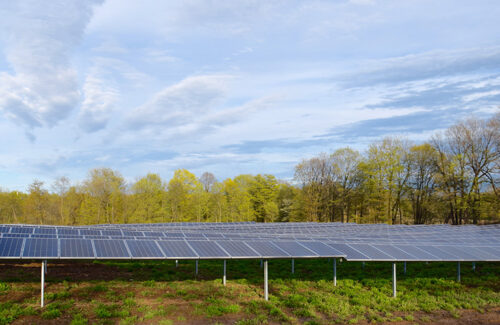
Ampion Renewable Energy has been selected as the community solar manager for the Erie County Low Income Sustainable Energy Program (ECLIPSE), a new initiative aimed at providing electricity savings for low to middle-income residents in Erie County, New York. Ampion will collaborate with Yili County to provide electricity savings for eligible residents through community solar energy. Currently, there are over 80000 low - and middle-income families in Yili County who can benefit from this program. We encourage residents to seize this opportunity, "said Mark C. Poloncarz, the Governor of Yili County. ECLIPSE community solar energy can be combined with other programs, such as the Home Energy Assistance Program (HEAP) and Empower+, to ensure that households can afford energy costs This program is applicable to all homeowners and tenants in Erie County who benefit from federal or state aid programs, including HEAP, Affordable Connect Program, Medicaid, Supplemental Nutrition Assistance Program, or Temporary Assistance for Poor Families. Brian Buzby, Director of Community Partnerships at Ampion, said, "Community solar allows power company customers to access renewable energy and save costs without installing or paying upfront fees. Through ECLIPSE, Erie County and Ampion make it easier for low-income residents to support solar energy while saving money. Our goal is to make the registration process as simple as possible. You only need a copy of your current electricity bill and proof that you are benefiting from government aid programs In addition to saving significant costs for impoverished families, this collaboration will also expand the amount of solar energy available in the northern part of New York State within the service areas of State Grid and New York State Electric and Gas Company (NYSE). Ampion recently announced that through community solar energy, users have saved over $42 million in electricity bills. These savings were achieved through the production of clean energy through a portfolio of over 1.5 GW community solar projects managed by Ampion.
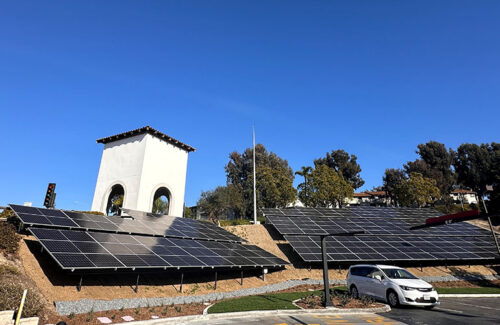
SolMicroGrid has announced the completion of a microgrid project at Chick-fil-A Quarry Creek in Oceanside, California. SolMicroGrid typically utilizes a combination of solar energy, on-site battery storage, and generators to provide customers with reliable and continuous power. The project for this Chick-fil-A restaurant includes an 81 kilowatt hour battery energy storage system and a 112 kilowatt solar cell array consisting of a canopy and ground mounted modules. All components of the project are controlled by an advanced energy management system that optimizes performance and maximizes the synergy between technologies. Due to the unique terrain and steep slope of the location, SolMicroGrid adopts ground installation technology specifically designed for rock slopes - using ground screws instead of standard concrete pouring foundations. One of the benefits of microgrid projects is that they can strategically deploy distributed energy resources, thereby reducing energy costs. The Oceanside project is expected to meet about one-third of the restaurant's annual energy needs, while grid electricity prices are 10% lower than grid electricity. Kirk Edelman, CEO of SolMicroGrid, said, "The solar and battery storage combination we provide for Chick-fil-A will help reduce energy costs while achieving sustainable development goals. We are pleased to have the opportunity to provide renewable energy to Chick-fil-A at a discounted price The latest achievement of SolMicroGrid and Chick-fil-A was achieved after the successful deployment of microgrids at the local owner operated locations of Chick-fil-A on Mendocino Avenue in Santa Rosa, California and March Lane on I-5 Interstate in Stockton. Peden Young, Chief Project Leader of the Sustainability Team at Chick-fil-A, stated, "Chick-fil-A's partnership with SolMicroGrid to invest in pilot solar microgrids demonstrates our commitment to environmental management. Using renewable energy on-site in our restaurant can reduce our impact on the environment, while also reflecting Chick-fil-A's determination to pursue the future and care for the planet
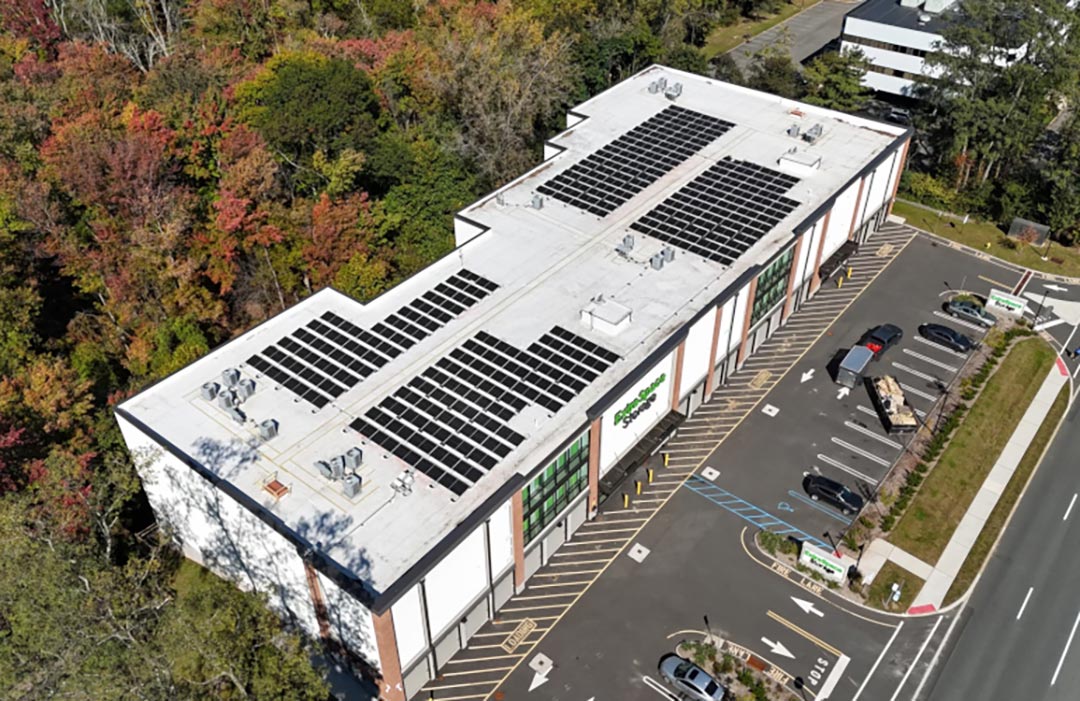
Key Properties has collaborated with Solect Energy to complete its first solar energy project. The 110 kW rooftop solar installation at the Key Properties Extra Space Storage building in Cedar Knolls, New Jersey is designed to offset 100% of the building's electricity usage. Adam Schlussel, Vice President of Key Properties, said, "Solar energy is a natural choice for us to reduce operating costs. By partnering with Solect Energy, we have reduced electricity costs from 17 cents per kilowatt hour to less than 1 cent and generated recurring income through incentive measures. For us, it's like adding another long-term tenant to the building Tony Johnson, Vice President of Business Development at Solect Energy, said, "Key Properties focuses on sustainability and maximizing financial value on this project, and we are pleased to work with them to achieve these two goals. This project not only offsets 100% of the building's electricity consumption, but also highlights the long-term economic benefits and environmental impact that solar energy can bring to commercial real estate owners The Cedar Knolls branch of Key Properties uses natural gas for heating and electricity for air conditioning and lighting. The solar energy system now completely offsets the electricity consumption of buildings. For their next solar project, Key Properties and Solect Energy are collaborating to design a system that will meet 100% of the energy needs of all electric buildings in the future.
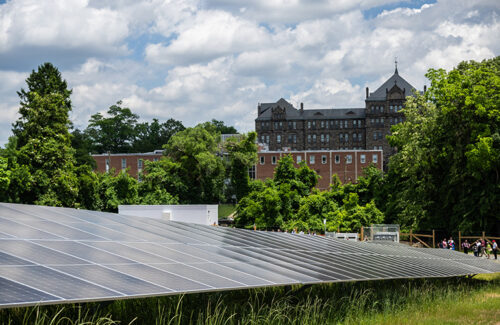
The facilities of Catholic University in the United States are located above the trees on both sides of the community solar project. This 7.5 MW project is located on Harwood Road across from the campus. Standard solar energy In cities like Washington, unoccupied land is very rare, let alone priceless. But the Catholic Church and CUA own more land than most organizations. I believe that besides the federal government, we are the largest landowner in Washington D.C., which is one of the reasons why we are able to develop 25 acres of solar panels on site, "said Gabrielle Choate, CUA Campus Sustainability Director. This 7.5 megawatt solar array occupies a portion of the 40 acre plot on CUA West Campus, with the remaining land reserved for ancient trees and nurseries. The project was developed by Standard Solar, which collaborated with CUA between 2009 and 2012 to develop a series of rooftop battery arrays and solar carports. Chuck VonDrehle, Senior Project Manager at Standard Solar, said, "The university has already utilized many net metering opportunities in other buildings... so this is a way for them to fulfill their previous commitments This century old university hired Standard Solar at the end of 2020, and in the following year, the developer collaborated with university, city, and community committees to design and approve community solar projects. This community solar project was launched in June 2024, and Standard Solar will lease the land for the next 20 years, but the developer has set the operating life of its project at 35 years. This array can accommodate approximately 1100 users and is open to residents in all eight districts of DC. CUA has ordered 12% of the total production of the array. They could have sold this land, which is very valuable in any urban area. They could have redeveloped it into a townhouse or even an academic building, and they still retained the option for the future because it is a temporary use for the next 20 years, which is just a short period of time for the life of a university, "Fennati said. The array on the west campus is obscured by natural surroundings on three sides and has no direct neighbors. Before construction, the site was an open space covered with wild shrubs and residual forests. The land slopes southward and is slightly flat to accommodate the solar cell array facing south. In order to build the system, some trees must be cut down, but many of them are donated to the urban forestry department of the regional transportation department. After processing, they will be provided to regional schools and high-risk youth projects for student projects and infrastructure construction. Another part of the wood is covered and used for CUA's community gardens and sidewalks. The remaining trees are considered important to the site, so installation personnel avoided the roots of ancient trees when piling. The array consists of FLEXRACK fixed tilt series brackets from QCells, CPS 275 kW series inverters, and ...

T1 Energy, the solar panel manufacturing player formerly known as FREYR, announced in its 2024 full-year report that it has chosen a site in Milam County, Texas, to establish a 5-GW solar cell manufacturing facility. The site located northeast of Austin will be labeled “G2 Austin,” while T1’s existing solar panel assembly outfit in Wilmer is called “G1 Dallas.” T1 has executed a lease and purchase option for 100 acres in the Advanced Manufacturing and Logistix Campus at Sandow Lakes. The company will invest up to $850 million into the site and is projected to create up to 1,800 new advanced manufacturing jobs. “Adding solar cell manufacturing is foundational to building out T1’s American supply chain. We are excited to take that next step right here in Texas, where the state’s leadership and business community has continued to develop the infrastructure, talent, and business climate necessary to support this project,” said Daniel Barcelo, T1’s CEO and Chairman of the Board. “We are grateful for the support we have received from the Wilmer, Austin, and Milam County communities and look forward to continuing to partner together moving forward.” T1 also announced that the ongoing ramp of production at the 5-GW solar panel assembly facility is proceeding ahead of schedule. During January and February 2025, the company produced more than 220 MW of panels at the plant that uses licensed Trina Solar technology. The site hosts four production lines for the utility-scale market producing a mix of PERC and TOPCon modules. T1 expects to reach 3.4 GW of production by year-end.

Terreno Realty Corporation has announced the completion of a 6.1 megawatt rooftop community solar project in northeastern Washington, D.C. The project covers approximately 700000 square feet and will be the largest rooftop community solar array in Washington, D.C. and one of the most important urban community solar projects in the United States. The solar cell array is driven by Black Bear Energy, owned by Aligned Climate Capital, and funded by DC Green Bank and Amalgamated Bank. It is expected to generate over 7 million kilowatt hours of clean energy annually, enough to power 965 single family homes. The energy generated by this project will be provided to low - and middle-income households through subscription, supporting the District of Columbia Sustainable Energy Utility Company's (DCSEU) "Solar for All" program and providing affordable solar energy to underserved communities. It is expected that this solar project will save $7.5 million for households in the District of Columbia over the next 20 years. Peter Davidson, CEO of Align Climate Capital, said, "Solar energy is already one of the most affordable sources of energy, and community solar energy helps ensure that these saved funds benefit those who need them the most. Align's investment in this project reflects our commitment to expanding the use of clean energy and supporting efforts to make renewable energy more widely accessible to households throughout the region The project partners jointly attended the ribbon cutting ceremony to celebrate the completion of the solar cell array. We are honored to support Terreno Realty in enhancing the value of its assets and surrounding communities. This project demonstrates our commitment to providing low-cost renewable electricity to the region on a large scale, "said Drew Torbin, founder and resident of Black Bear.

The Miami Dade County Commission and regulatory authorities have issued an acceptance notice for QuickBOLT stone coated steel roof hooks, approving their use in adverse weather conditions. Miami Dade County is the regulatory agency for building products, responsible for determining whether building products are suitable for use in high-speed hurricane environments. The stone coated steel roof hook is a stainless steel bracket designed for stone coated steel roofs. We have always been committed to manufacturing brackets that are easy to install, minimize roof damage, and provide unparalleled durability, "said Rick Gentry, Head of New Products at QuickBOLT." This is a difficult balance, but this approval proves that we are on the right path
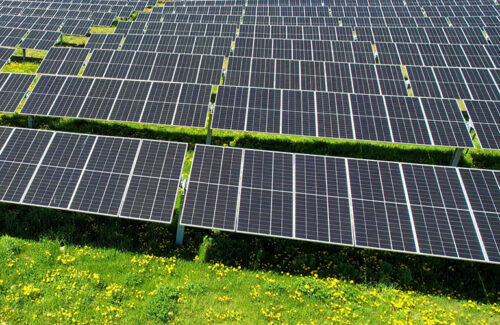
When the House Ways and Means Committee began planning the government's 2025 budget under President Trump, 21 House Republicans signed a letter requesting committee chairman Jason Smith (R-MO) to retain the existing energy tax credits. This letter is led by Congressman Andrew Gabarino (R-NY) and shares the same views as a similar letter last summer, which was signed by 18 Republican lawmakers demanding that Speaker of the House Mike Johnson (R-LA) retain the Irish Republican Army. In our letter dated March 9th, we write to emphasize the importance of prioritizing affordable energy for American households and maintaining our current energy dominance in efforts to repeal or reform existing energy tax credits The Republican Party points out that the long-term certainty of IRA is crucial for developers to plan and fund domestic energy projects in the United States. Many tax credits are established within a decade, which allows energy developers to consider these tax incentives when planning. These timelines have been heavily dependent on capital allocation, planning, and project commitments, all of which are threatened by additional restrictive mechanisms such as premature cancellation of tax credits or restrictions on transfers, "the Republicans wrote.
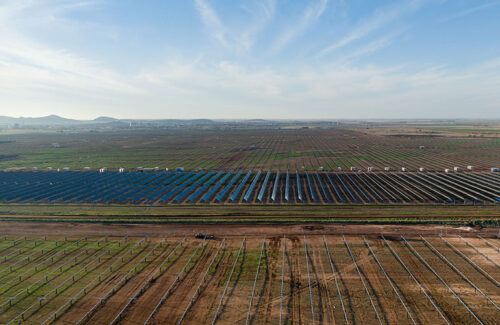
Savion announced today that the Kiowa County Solar Power Project (KCSP) located in Kiowa County, Oklahoma, has begun commercial operations. This 100 megawatt solar facility is Savion's first project developed, constructed, and owned in the state. The project covers an area of 1235 acres and started construction in August 2023, with completion in December 2024. It includes over 189000 double-sided solar panels. We have signed a long-term power procurement agreement with a Fortune 100 technology company to purchase all the production capacity of the facility. The solar project is located in the southwest of Oklahoma, adjacent to Snyder Town, and is expected to generate enough electricity annually to power approximately 21000 households in Oklahoma for the next 40 years. The project will be interconnected with the AEP substation and connected to the Southwest Power Alliance. SOLV Energy is responsible for the EPC work of the site, while Shell Renewable Asset Management International (SRAMI) is responsible for overseeing asset management. Savion President Nick Lincon stated, "The launch of the Kiowa County solar project will expand Savion's operational asset coverage and emphasize our mission to own and operate solar facilities that contribute to injecting clean energy into the US power grid. The launch of this project marks another milestone for Savion as an independent power producer, and more facilities will be put into use in the future
Categories
New Products
Tin Roof Rapid Solar Mounting System with Hanger Bolt Read More
Residential Small Solar Easy Bracket Kit for Home Balcony Read More
Automatic Single Pile Solar Tracker with 10 PV Panels Read More
Angle Adjustable Aluminum Easy Solar Panel Bracket for Garden Read More
Intelligent Single Post Dual Row Solar Tracking System Read More
5000ES Solar Off-Grid Energy Storage Inverter Supplier Read More
Multi Drive Double-Sided Single Axis Tracker System Read More
© Copyright: 2025 Xiamen Wintop New Energy Tech Co., Ltd.. All Rights Reserved.

IPv6 network supported
Friendly Links:
Integrated Solar System